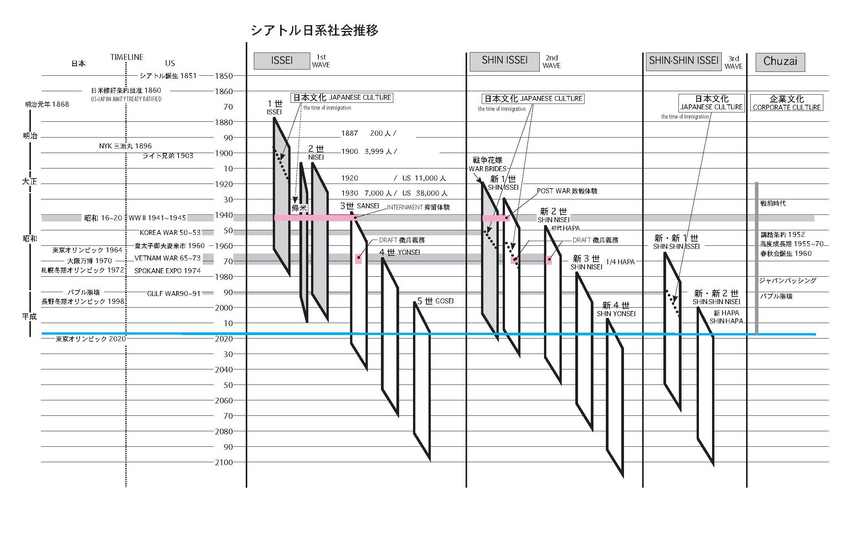

2017年3月 北米報知掲載
「日系人社会」とは?
“「日系人」は何人位いますか?” 観光にしろ仕事にしろ、日本から訪れた人から必ず出るのが、この質問。以前は「日本人」は何人位いますか?だった。移民130年にして、やっと日本の人にも、アメリカには日本人を祖先とするアメリカ人もいるのだという事が理解されてきたのだが、海外在留邦人、日系人社会などと呼ばれる,その中身は複雑である。 その所謂「日系人社会」の中にあっても個々の背景は文化的社会的に異なり大きな差がある。日本のように北から南まで共通した価値観によるのとは大きく違う。初期の一世時代のように、まず日本人であること、次に同郷人であることで互いを拠り所にしたのと違い、最近の移住者はアメリカ社会に受入れられる事を当然とし、最初から独立起業など同胞(今の人には死語 ?)を頼らぬ自信も有り、仕事を除けば、接触が無いか少ない傾向にありますが、ここにきて少数民族や宗教に対し、あからさまに差別危害を加える輩が出て来るなど、被差別対象マイノリティーであるという、日本にいては想像も出来なかった事実に直面する危険が起き始めています。
御自分や子供達、友人、知人が、どのブロックに属するかを知り、夫々の社会観や価値観の背景を理解する事は、「日系人」として、この国で暮らして行くには仕事の上でも、個人としての付き合いでも、不可欠であると思います。
そこで「日系人社会」という国勢調査の数字だけでは判らないものを、俯瞰的に大きな波として目に見える形にすることを試みてみました。但し、これは学術的に正確なものではないことは予め御断りしておきます。各年代のブロックは80才を平均寿命とし、出生年には20年の巾を持たせましたが、ブロックのサイズは人口に比例したものではありません。あくまでも大きな波を掴んだものであって、高低はありますが途切れてはいません。例えば遅く生まれた2世であって世代的には同級生が3世に属する方もおられますし、「新1世」でも数は少ないですが、50年代初めには留学目的で渡米された方もおられます。
「1世」「新1世」「新・新1世」における「点線」は渡米時期(各世代の日本文化を持ち込んだ時期)を示します。「新1世」という呼称は当初一世からは、苦労も知らずに「一世」という言葉を気軽に使うなとのお叱りを受けた事もあったのですが、国際結婚した女性を中心に広がりました。「新・新1世」は筆者の造語です。「帰米2世」についてはあらためて説明しませんが、特に日本文化の影響を考え独立のブロックとしました。
特筆したいのは「新1世」の男子の場合、ベトナム戦争中は日本国籍であれ,学生、駐在員であっても徴兵対象となり、実際に徴兵され従軍された方もいた事です。この時期の渡米者は筆者も含め、米国に対し違った感情を持っています。「新・新1世」男子が徴兵の対象にならなかったのは幸運でしたが、徴兵制は大統領の一言で復活します。その場合は在留外国人にも容赦なく適用されるでしょう。
「新2世」の特徴は「新1世」の母を持つ初代の「ハパ HAPA」が多くを占める事です。初期の「混血」「ハーフ」などという呼称が侮蔑的であるとして、ハワイ語を語源とするのが日本人だけでなく他の人種間の血をひく場合もの一般呼称となりました。「新・新2世」世代も多くの「新HAPA」を含みます。
「ハパ」でない「新2世」は両親が戦後移住者で、日本文化を避ける示唆や影響を受けていない事が、同世代の「3世」と異なります。
What is a Nikkei Community ?
“How many Nikkei live here?” Either as businessman or as tourist, this is a question always asked. Question used to be, “How many Japanese live in this area ?” After 130 years of Japanese immigration in this area, the visitors finally understood the fact that there are generations of Americans who are descendants of Japanese settlers. However, “Nikkei community” or “Japanese community” is very complicated.
Even within the so called “Nikkei community,” backgrounds are varied socially and culturally. Early Issei immigrants relied on being Japanese and if one was from the same local area in Japan (doukyo) became comrades and helped each other. In contrary, recent immigrants are more confident and independent and even start new businesses right away and take it for granted they would be accepted into American society and not look for community help.
However, the tide is changing with undesirable movements of racists and white supremacists noticeable now. Thoughts of becoming a victim of such racially or religiously motivated discriminations are unthinkable in Japan, but what happened some seventy years ago here is starting up again.
It is important to know and understand where you, your children, friends or acquaintances stand in this society.
On this chart, I am trying to catch the major wave or trend of Nikkei immigration that one is unable to see from the Census numbers. This is not an academic study. Each block or group shows average life expectancy of 80 years old and a span of 20 years of birth date. The size of block is not proportioned to the population of the group. It is my intention to show the major trend or characteristic of the group. For example: if you are late born Nisei, it is possible, generation-wise, most of your friends are Sansei.
The dotted lines of Issei, Shin Issei, Shin-Shin Issei show the period of immigration (Time of each generation bringing in Japanese culture). When the word “Shin Issei” was used for the first time, some Issei objected because it seemed to disrespect their generation, not having experienced the hardship they went through. However, the usage was spread by international marriage groups. “Shin-Shin Issei” is a word made up by the author. I will skip the explanation of “Kibei Nisei” but feel they were a significant influence on carrying on Japanese culture, so a separate block is made from general Nisei.
One important note is a case of “Shin -Issei” men. During the Vietnam war period, regardless of nationalities, students, visitors or workers for foreign company, all were subject to U.S. military service draft (until 1973). They were even some who served in the infantry and returned wounded. Anyone who immigrated during this period including myself has uneasy feelings toward this country. “Shin-Shin Issei” are very lucky not to have experienced that.
One characteristic of “Shin Nisei” is many first “HAPA” generation who were born between Japanese and American parents are in this group. Words like “Konketsu” and “Ha-fu” were once considered inappropriate, Hawaiian word “Hapa” became common and now even refers to mix of different races other than Japanese. Near perfect bilinguality (bi-cultural) comes out from this group.
Wartime experiences made many Nisei generation reluctant to endorse traditional culture to Sanseis. Yonsei became more assimilated resulting in having the highest inter-racial marriages among all Asian populations. The last Census reported that some over 100 thousand in this area were registered as part Japanese. However how many of them are familiar with Japanese heritage or customs and even think they are members of the Nikkei community?
- If you are a bloguru member, please login.
Login
- If you are not a bloguru member, you may request a free account here:
Request Account